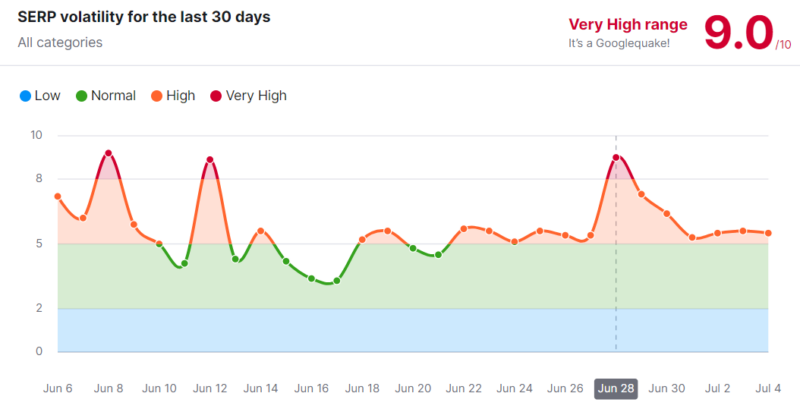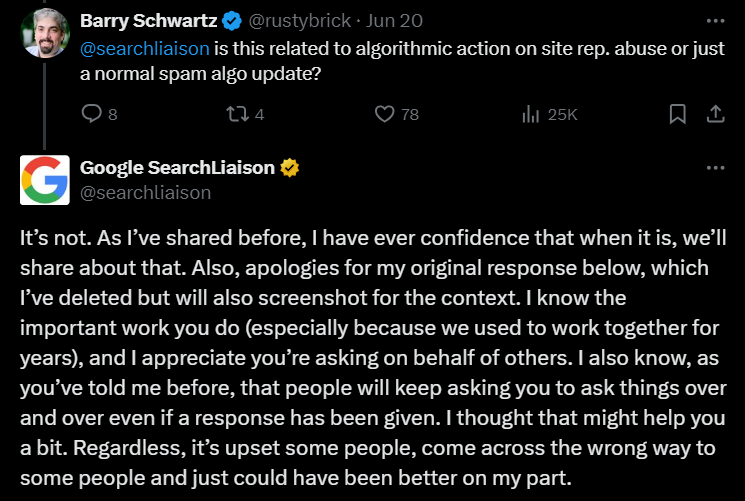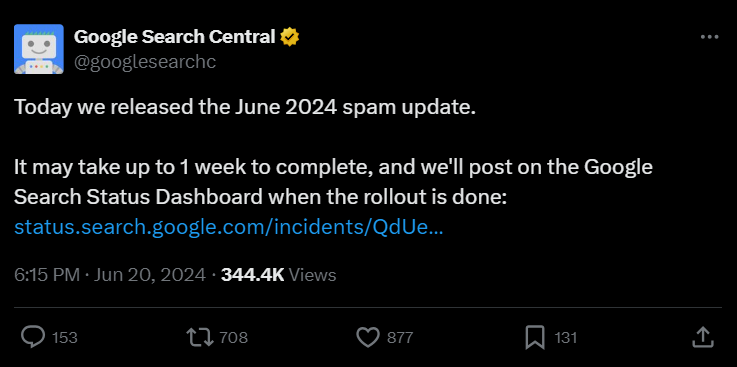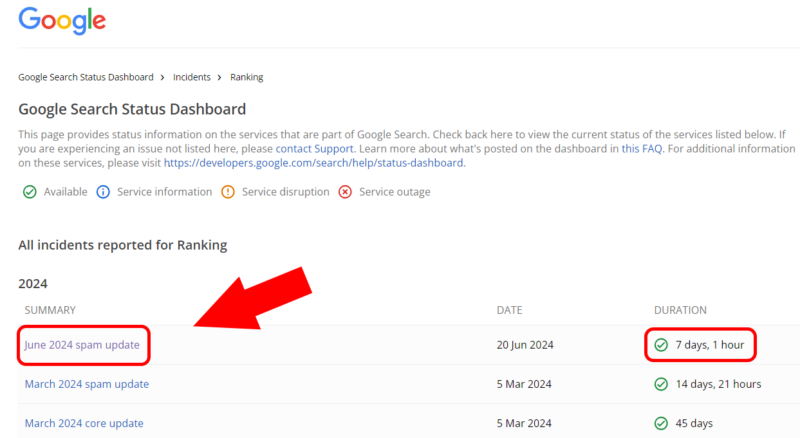In its ongoing effort to improve search quality, Google has completed the rollout of its June 2024 spam update. This update, which began on June 20 and concluded on June 27, 2024, marks another step in Google’s continuous battle against web spam and low-quality content.
The June 2024 spam update is a broad, global update targeting websites that violate Google’s spam policies. Unlike some previous updates, this one is not focused on link spam or the site reputation abuse policy. Instead, it aims to refine Google’s ability to detect and penalize various forms of web spam across all regions and languages.
As with any significant algorithm update, website owners and SEO professionals may notice fluctuations in search rankings. This article will go into the details of the update, its potential impact, and what actions site owners should consider in response.
TABLE OF CONTENTS:
First, Some Quick Facts:
- The update rolled out from June 20 to June 27, 2024
- This is a broad spam update, not specifically targeting link spam
- Websites violating Google’s spam policies may see ranking changes
- Google recommends reviewing its spam policies if you notice impacts
- Recovery from this update may take several months
Key Details of the June 2024 Spam Update
Google’s June 2024 spam update represents another step in the search giant’s ongoing efforts to maintain the quality and relevance of its search results.
The primary goal of this update is to enhance Google’s ability to detect and penalize websites that violate its spam policies. By refining its spam detection algorithms, Google aims to improve the overall quality of search results for users.
Here’s the impact we noticed on June 28, 2024, once the spam update was completed:

Industries most affected (these are anything over a 9 on Semrush’s scale) include:
- Arts & Entertainment
- Business & Industrial
- Computers & Electronics
- Finance
- Food & Drink
- Games
- Health
- Home & Garden
- Internet & Telecom
- Jobs & Education
- Shopping
- Online Communities
- News
- Sports
We dug into our clients’ SEO strategies and tracked their key terms, and we spotted something interesting. One of our clients is showing a volatility score of about 8, making them the most volatile in our bunch. Meanwhile, most of our other clients are holding steady.
There’s been some chatter in the industry about sites getting unfairly hit by the June 2024 spam update, but from what we can see, that’s not the case for our crew. No manual actions in sight!
What the Update Targets
This broad spam update focuses on various forms of web spam, including:
- Scaled content abuse: This refers to content created by software rather than humans, often with the sole purpose of ranking in search results. It typically lacks coherence, depth, or value for users. For example, auto-generated articles that string together keywords without providing meaningful information.
- Cloaking and sneaky redirects: Cloaking involves showing different content to search engines than to users. Sneaky redirects automatically send users to a different page than the one they clicked on in search results. Both techniques aim to manipulate search rankings by deceiving either users or search engines.
- Hidden text or links: This involves placing text or links on a page in a way that’s invisible to users but detectable by search engines. Common methods include using text the same color as the background or placing links in single-pixel images. The goal is to stuff keywords or build link equity without affecting the user experience.
- Scraped content: This is the practice of copying content from other websites and republishing it without adding significant value. It can range from wholesale copying of entire pages to assembling content from multiple sources without original commentary or analysis.
- Participating in link schemes: This involves any attempts to manipulate a site’s ranking by artificially increasing the number of links pointing to it. Examples include buying links, excessive link exchanges, or using automated programs to create links across many sites.
- Creating pages with little or no original content: These are often called “thin” content pages. They provide little value to users and exist primarily to rank for specific keywords. Examples include doorway pages, affiliate pages with mostly product feeds, or pages that simply restate information from other parts of the site.
- Keyword stuffing: This is the practice of loading a webpage with keywords in an attempt to manipulate a site’s ranking in Google search results. This can include lists of keywords, groups of keywords that are out of context, using keywords that are not relevant to the page’s topic, or repeating the same words or phrases so often that it sounds unnatural.
- User-generated spam: This involves spammy content added to otherwise legitimate sites, often through comments, forums, or user profiles. It can include irrelevant links, nonsensical text, or promotional content unrelated to the site’s topic.
The update aims to identify and take action against websites employing these and other spammy techniques that violate Google’s Webmaster Guidelines.
What the Update Does Not Target
It’s important to note that this update is not:
- A link spam update: Unlike some previous updates, this one does not specifically target link spam practices.
- An automation of the site reputation abuse policy: Google has clarified that this update does not implement algorithmic enforcement of its site reputation abuse policy:

Google continues to handle site reputation abuse cases through manual actions rather than algorithmic updates. Some recent major updates it has rolled out include:
- March 2024 Core Update: Began rolling out on March 5, 2024, and completed on March 15, 2024. This was a significant broad core algorithm update that impacted search rankings globally.
- March 2024 Spam Update: Rolled out from March 5 to March 20, 2024, overlapping with the March core update.
- November 2023 Core Update: Rolled out from November 2 to November 28, 2023.
Struggling after a Google algorithm update? Single Grain’s SEO experts can help!👇
Google’s Communication About the June 2024 Spam Update
Google has been relatively transparent about the June 2024 spam update. It initially announced the update via its Google Search Central account on X (formerly Twitter) on June 20, 2024. The tweet stated:

On June 27, 2024, Google confirmed the completion of the rollout through its Search Status Dashboard:

Google’s Guidance for Affected Sites
Google has provided general guidance for sites affected by spam updates. In their spam updates documentation, they advise:
“Sites that see a change after a spam update should review our spam policies to ensure they are complying with those. Sites that violate our policies may rank lower in results or not appear in results at all. Making changes may help a site improve if our automated systems learn over a period of months that the site complies with our spam policies.”
For more detailed information about Google’s spam policies, website owners are directed to review the Google Search Central documentation on spam policies.
As usual, Google didn’t provide specific details about changes made in the spam update. This is to prevent spammers from finding ways to circumvent the new detection methods. Instead, they encourage adherence to their general webmaster guidelines and spam policies.
Recommendations for Website Owners and SEO Professionals
If your website has been affected by the June 2024 spam update, or if you want to preemptively protect your site from future updates, consider the following recommendations:
Steps to Take if Affected by the Update
- Analyze your traffic: Use Google Analytics or your preferred analytics tool to identify specific pages that experienced significant traffic drops coinciding with the update rollout (June 20-27, 2024).
- Review Google Search Console: Check for any manual actions or security issues reported in Google Search Console. While this update was algorithmic, it’s always good practice to ensure your site is free from manual penalties.
- Conduct a content audit: Systematically review your content, focusing on pages that saw ranking changes. Look for thin content, duplicate content, or pages that provide little value to users.
- Assess your link profile: Although this wasn’t a link spam update, it’s wise to review your backlink profile using tools like Google Search Console, Ahrefs, or Majestic. Disavow any spammy or low-quality links you can’t remove manually.
- Check for technical Issues: Ensure your website isn’t inadvertently cloaking content or using sneaky redirects. Tools like Screaming Frog can help identify these issues.
- Monitor your competition: Analyze competitors who may have benefited from the update. This can provide insights into what Google considers high-quality, spam-free content in your niche.
Best Practices for Avoiding Spam Penalties
To avoid potential penalties from spam updates, focus on creating original, high-quality content that provides unique value to your users. This aligns with Google’s helpful content system (E-E-A-T), which, while separate from spam updates, shares the goal of promoting valuable content:

If you use schema markup, ensure it accurately represents your page content. Misuse of structured data can be considered a form of spam, so it’s crucial to use it correctly. For sites that allow user-generated content such as comments or forums, implement strong moderation practices to prevent spam from appearing on your pages.
We also strongly recommend regularly updating and improving your content. This is something we do every six months here at Single Grain. It not only keeps your content fresh and up-to-date but also signals to Google that your site is actively maintained.
Finally, if you use AI tools for content creation, be cautious. While Google doesn’t outright penalize AI content, there is evidence that AI-generated content performs poorly in terms of traffic when compared to human-written content:

Ensure that any AI-generated output is thoroughly reviewed, edited, and enhanced by humans to add unique value. A human touch can help ensure that your content meets Google’s quality standards and provides real value to your audience.
Important Facts to Remember
If you’re dealing with the aftermath of a spam update, it’s crucial to understand that recovery is not an overnight process.
Google has explicitly stated that recovery from spam updates can take several months as their systems learn and adapt. This means that even after making significant improvements to your site, you may not see immediate results in your rankings or traffic.
Another important aspect to keep in mind is that Google performs periodic refreshes to this spam update, so your site’s status in the search results can change over time, even without you making additional changes.
Unlike manual actions, which have a reconsideration process, algorithmic updates like this spam update don’t offer quick fixes. There’s no way to submit your site for immediate re-evaluation after making changes. Instead, improvements need to be substantial and sustained over time for Google’s algorithms to recognize and reward them.
Lastly, it’s important to note that this update has a global impact, affecting all regions, and languages. If you manage international sites or multilingual content, you should apply these recommendations across all your content, regardless of the language or target region to ensure a consistent approach to quality and compliance with Google’s guidelines across your entire web presence.
Last Thoughts on Google’s Ongoing Fight Against Web Spam
The June 2024 spam update underscores Google’s commitment to delivering high-quality, relevant results to users while maintaining a fair playing field for website owners and content creators.
The key takeaway is that focusing on creating valuable, original content and adhering to Google’s guidelines is more crucial than ever. As search algorithms become increasingly sophisticated, attempts to game the system are likely to yield diminishing returns and potentially severe penalties.
For SEO professionals and website owners, this update serves as a reminder to stay vigilant, regularly audit your sites, and always prioritize the user experience. The landscape of search is ever-evolving, and adaptability is key to long-term success!
Related Video
If you need help recovering after Google’s algorithmic updates, Single Grain’s SEO experts can help!👇
For more insights and lessons about marketing, check out our Marketing School podcast on YouTube.



